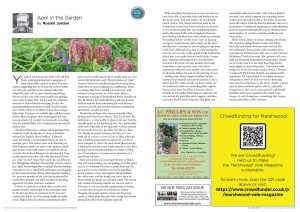
Yet again I am writing this while still suffering from waterlogged land and a quagmire of mud where there used to be lawn. I’ve seen reports suggesting that we’ve had the wettest winter for 130 years and that seems entirely believable. Hopefully there will be some rebalancing, during the rest of the year, with lower rainfall and perhaps even some summer heat. It’s not only the excessive amount of water which is worrying, it’s also the correspondingly prevalence of dull, cloud covered, skies which will have resulted in lower than average light levels. Variations in available light will have more subtle effects on plants than waterlogged soils but, because plants rely on light for practically everything they do, reduced light, over a long period, can only be detrimental.
One plant that enjoys a damp soil, originating from meadows in the flood plain of rivers, is Fritillaria meleagris the ‘Snake’s-Head Fritillary’. I planted some last autumn, as dormant bulbs, in an area of meadow grass. The earliest ones were flowering on 23rd February, much too early in my opinion, which may be due to the mild winter but could also be an anomaly due to them being newly introduced. I hope in subsequent years they will settle down and flower at a more ‘normal’ time which would be, according to the ‘Floodplains Meadows Partnership’ website, mid to late April. Interestingly, they conclude that this fritillary responds to stress, specifically prolonged waterlogging, by becoming dormant. When submerged by flooding for up to ten months of the year they responded by hardly flowering the year after; not ideal as flooding appears to be more and more common.
If there is a period of settled, drier, weather this month then it’s a good time to try and repair some of the damage done to your lawn if the excessive wetness has led to areas becoming muddy or traffic worn. Higher, but not extreme, temperatures allow grass seed to readily germinate if muddy areas are over sown with fresh lawn seed. The prevalence of ‘April showers’ means that artificial irrigation is unnecessary while the new grass seedlings are establishing. There is a danger that heavy rainfall will wash away seed before it can germinate so, if this looks likely, a temporary covering of horticultural fleece should stop this. Protecting the seed with fleece will also prevent birds or rodents from consuming the seed before it can root and will also save the seed from mechanical disturbance (usually human!).
Horticultural fleece also comes in handy when dealing with that elusive beast; ‘The Last Frost’. By definition it is impossible to plan in advance for this specific point in the gardening year. In a particularly mild year, especially in the generally warmer climate of the south west, it is possible that the last frost has already occurred. Having said that, it is not unheard of to have a frost as late as May, although that would be particularly traumatic. If you have been tempted to plant out seed raised plants during a mild spell, or have sown hardy annuals in situ, then having some horticultural fleece on hand, to fling over them whenever temperatures plummet, is a good back-up plan.

Seed sown under cover during February or March may well need pricking out and potting on at this point even if it’s definitely too soon to plant them out. It’s getting late to sow annuals, to be used a gap fillers in the summer, as late sown plants will lag behind the earlier ones and day length may cause them to flower while the plants are still quite small. The reason why summer flowering annuals are sown as early as February, if you can provide supplementary heating, is so that they can grow to a decent size before changing day length switches them into flowering mode, at which point they put their energy into flower production rather than vegetative growth.
With everything having been so wet you may not have been able to get onto beds and borders to do the usual ‘weed, feed and mulch’. If you did add a feed, such as fish, blood and bone, early in the season then it may have been washed away by now so it’s worth ensuring that any establishing plants, spring flowering bulbs and emerging herbaceous perennials get another dose now, weather permitting. Everything will be ‘on the move’ now so keeping on top of weed removal and looking out for pests and diseases is essential if you are going to nip them in the bud. Although they may be well emerged by now, it’s not too late to dig up and divide herbaceous plants that have made decent sized clumps. Longer days, warming soil temperatures and abundant moisture will ensure that any divided perennials (remember to incorporate some feed when replanting) will grow away quickly and make good sized plants before the end of the growing season.
Adding your chosen support method, before herbaceous perennials have grown too tall, is also a timely task. Pea sticks, usually cut hazel wands, are the traditional solution to providing plant support because they have the ability to become almost invisible in the border. Push their cut ends into the soil, around the plant that needs support, and then weave the flexible hazel twigs over that plant and around the other hazel wands. This makes a kind of inverted ‘nest’ which supports the extending shoots as they grow up and through it. Pea sticks need to be cut in the winter while the hazel is dormant, they are a by-product of traditional coppicing, so some planning ahead is required although they can be obtained from local suppliers if you have nothing suitable in your own garden.
There will be plenty of plants coming into bloom this month as spring flowerers take over where the bulbs and winter flowerers have left off. On the herbaceous front, plants such as pulmonarias, epimediums and brunneras take over as the ‘Oriental Hellebores’ finish flowering. Also, primulas of every kind are blooming in profusion before many shrubs are even into leaf. Of the early flowering shrubs many highly scented viburnums, Viburnum x juddii being one of my favourites, or the similar Viburnum x burkwoodii ‘Park Farm Hybrid’, are indispensable specimens. It’s a good time to visit plant nurseries and garden centres to look for what is flowering now and choosing them ‘in the flesh’. April is a good time to plant container grown shrubs, especially evergreens, as they are in active growth and should establish well in your garden before there’s any danger of soils drying out—something that seems a remote possibility at this juncture.




